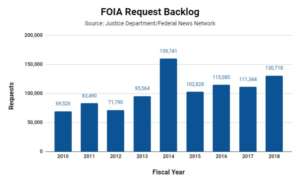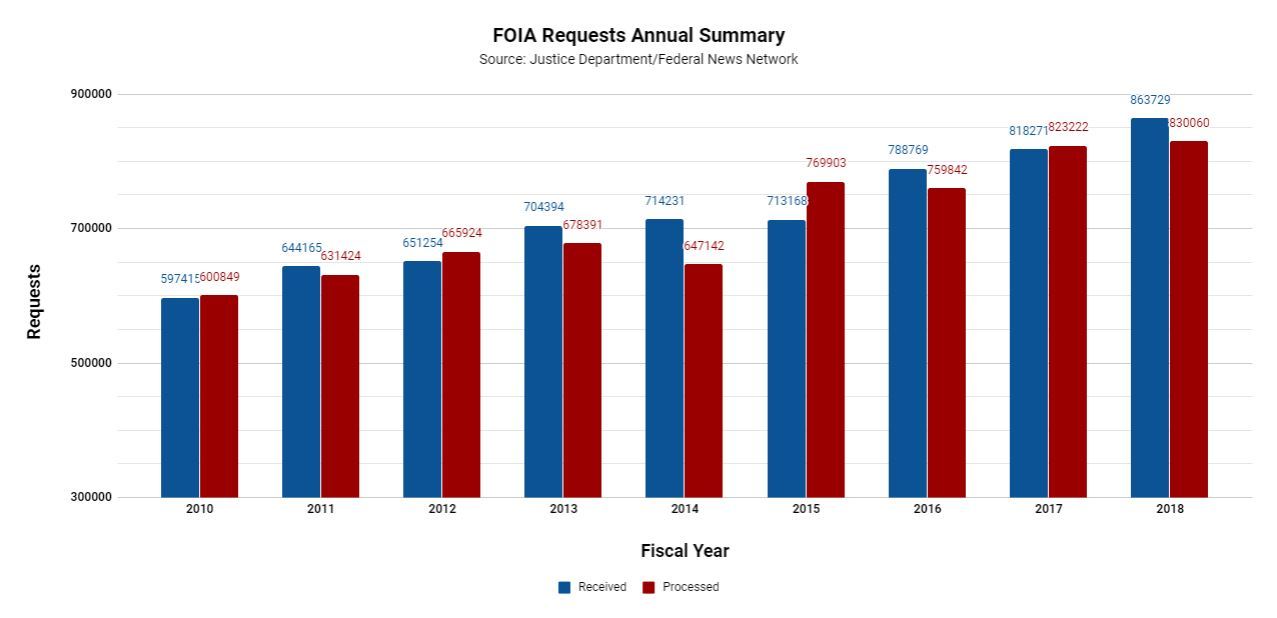
2018 sees record number of FOIA requests, information seekers change
The Justice Department’s prediction that fiscal 2018 would be a record year for Freedom of Information Act requests came true.
The Justice Department’s prophecy that fiscal 2018 would be a record year for Freedom of Information Act requests came true. But as the number of requests continues to rise, the make-up of people submitting most of them has shifted.
Journalists are now the second-most common requesters of government records; the majority are now people seeking information on themselves.
In FY 2018 federal agencies received 5.6% more requests, or an increase of 45,458, than in FY 2017, for a total of 863,729 requests. Collectively, agencies also processed 0.85% more requests, or 830,060 total, in FY 2018 versus the previous year, according to DOJ’s annual report released Thursday.
FY 2018 was the third consecutive year-over-year increase in the number of requests received, and the second consecutive YOY rise in processed requests. Five organizations lead the pack, accounting for more than 70% of all FOIA requests received and processed: the departments of Homeland Security, Justice, Defense and Agriculture, and the National Archives and Records Administration.
Altogether, DOJ counted a 93.8% release rate of information for FY 2018. Of those 830,060 processed requests, more than 70% were closed after being substantially processed. According to the release, 38.9% of them were at least partially granted, 26.9% were fully granted, 14.8% were closed due to a lack of records and 4.3% were fully denied based on FOIA exemptions.
The most commonly cited exemptions were Exemptions 6 and 7C, which both have to do with personal privacy interests. These range from personnel and medical files — Exemption 6 — to information for law enforcement purposes that when disclosed “could reasonably be expected to constitute an unwarranted invasion of personal privacy” — Exemption 7C.
The report concluded by saying that despite the increase in request processing, agencies have room for improvement. DOJ recommended agencies continue to target the 20-working-day deadline to respond to simple FOIA requests and close their 10 oldest pending requests and consultations.
 But the rise in processing wasn’t enough to stop the federal FOIA backlog from growing as well. The backlog for FY 2018 was 130,718 requests, up from the previous three years but still not as high as in 2014, which saw 159,741 backlogged requests governmentwide.
But the rise in processing wasn’t enough to stop the federal FOIA backlog from growing as well. The backlog for FY 2018 was 130,718 requests, up from the previous three years but still not as high as in 2014, which saw 159,741 backlogged requests governmentwide.
DOJ’s report said seven agencies were responsible for roughly 82% of that inventory: DHS, DOJ, and the departments of State, Health and Human Services; Veterans Affairs and Interior. One bright spot was that the time to process simple requests hastened, from 27.96 days in FY 2017 to 25.52 days in FY 2018.
Rise of first-person requesters
Aside from the sheer number of requests, agencies’ FOIA offices face another growing problem. While FOIA laws were designed with news organizations and journalists in mind, for the purposes of government accountability, these groups are no longer the most common requesters.
Margaret Kwoka, an associate professor at the University of Denver Sturm College of Law, presented research to the NARA FOIA Advisory Committee on Thursday, that individual requesters are turning to FOIA “by the hundreds of thousands” for their own records on matters such as their own immigration documents, medical and family histories. They also submit FOIA requests to obtain information needed to receive benefits, such as from the Veterans Health Administration.
The Social Security Administration has also seen several requests from people doing genealogy research, while the Equal Employment Opportunity Commission mostly gets requests for charge files, she said. Her findings mainly focused on DHS, VA, SSA and the EEOC.
Kwoka said the mismatch between FOIA’s design and need means that people are denied their due process, agencies become less efficient and public trust in those agencies is undermined.
Related Stories

FOIA request volume in FY 18 ‘well on-pace’ to break new records

Why a FOIA workforce shortage? Employees may see work as ‘punishment’
She described moving certain information requests out of FOIA offices, like is done at the IRS, and putting more medical records online as a couple ways to cut down the backlog.
FOIA office staff numbers still low
Federal FOIA offices have struggled to cope with stagnant staffing levels in the face of growing workloads.
As of October, agencies only had about 4,500 FOIA officers to handle requests and a NARA study presented in March estimated about 188 requests for every FOIA officer.
During Thursday’s committee meeting, Jason Baron, an attorney with Drinker Biddle & Reath and expert in the preservation of electronic documents, said that across the board agencies are engaging in “tremendous” amounts of FOIA training, particularly at DHS.
However, he also warned agencies still have a long way to go when it comes to digital records management, particularly emails. He said he hoped the committee could foster dialogue with FOIA officers about what tools and technologies exist in the marketplace to tackle this transition.
“They may not have experienced the need yet for searching across millions of emails for the typical FOIA request — that’s not the typical FOIA request that an agency receives — but the future is coming,” he said.
Copyright © 2025 Federal News Network. All rights reserved. This website is not intended for users located within the European Economic Area.
Amelia Brust is a digital editor at Federal News Network.
Follow @abrustWFED




